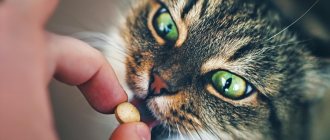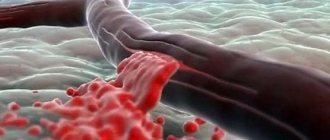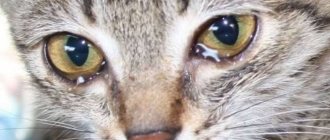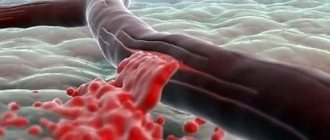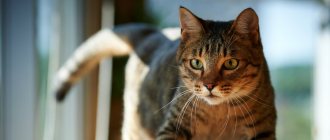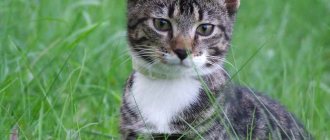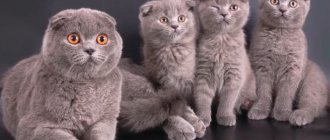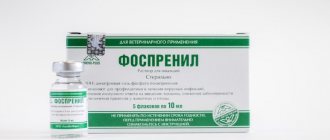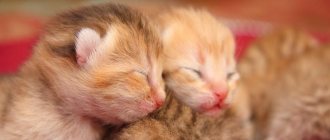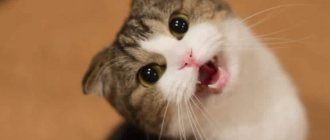What is heart disease?
The heart is the most important organ in a cat's body. It pumps blood containing oxygen and nutrients through blood vessels to the body's cells. Most heart diseases are associated with decreased efficiency of blood pumping. This can cause fluid to accumulate in the chest and abdomen. There are two main types of heart disease: one affects the heart valve and the other affects the heart muscle. In both cases, these conditions can be controlled by ensuring proper nutrition and exercise regimen. If necessary, the use of veterinary drugs may also be required. The right food and advice from a veterinarian can help your sick cat live an active life and enjoy every moment of it, despite her illness.
Two main types of heart disease
Chronic valve disease: A heart valve that leaks blood through reduces the amount of blood that can enter the body.
Heart muscle disease: Weakened or thickened heart muscle reduces the efficiency of pumping blood.
Heart disease in older cats: symptoms, diagnosis, treatment regimens
Heart disease is very common in cats, but in many cases the symptoms are hidden for a long period of time. This is a progressive disease that ends in the development of congestive heart failure. At this stage, cats exhibit very severe symptoms.
Types of Heart Disease in Older Cats
Heart disease in older cats primarily occurs as a disorder of the heart muscle and is called cardiomyopathy (cardio = heart, myopathy = muscle dysfunction)
Hypertrophic cardiomyopathy
The thickness of the heart muscle increases, so the heart cannot contract and relax properly. This leads to decreased blood flow in the body.
Restrictive cardiomyopathy
Scar tissue in the heart chamber muscle makes the heart very stiff, and the heart can no longer pump blood through the body.
Dilated cardiomyopathy
In this case, the heart muscle becomes thinner and loses its ability to contract properly.
Diagnosis
Although you may not see any clinical signs, your veterinarian may be able to detect the disease in its early stages during a clinical examination. Heart murmurs and changes in heart rate and rhythm can be early symptoms of heart disease. Once any of these symptoms are detected, your veterinarian may recommend further testing to verify the diagnosis.
- Electrocardiography
- Radiography
- Cardiac ultrasound and echocardiography
- Blood pressure measurement
- Tests for possible underlying conditions (eg, thyroid hormone levels)
The most important symptoms of congestive heart failure are:
- Frequent or difficult breathing
- Weakness or lethargy
- Weight loss and loss of appetite
- Blood pressure measurement
- Tests for possible underlying conditions (eg, thyroid hormone levels)
Please contact your veterinarian if you observe one or more of these symptoms in your cat.
Accompanying illnesses
Cats with cardiomyopathy are also at risk of developing blood clots due to impaired blood flow. These clots form in the heart chamber and, after leaving the heart, become lodged at the next bottleneck in the vascular system, cutting off blood flow. This is a complication of hypertrophic cardiomyopathy and is accompanied by symptoms such as cold feet, lameness and severe pain. This condition requires emergency medical attention.
Treatment and control of the disease at home
Once your veterinarian diagnoses cardiomyopathy, he or she will provide treatment recommendations and encourage you to get tested regularly. Your veterinarian may adjust the treatment protocol after each examination and may add antithrombotic medications, antihypertensives, or diuretics, depending on your cat's clinical condition.
To monitor the success of treatment, counting the resting respiratory rate is very important. A healthy cat at rest should have a respiratory rate of less than 40 breaths per minute. As soon as the respiratory rate increases, count again. If the respiratory rate still exceeds 40 breaths per minute, contact your veterinarian for further advice.
Cats with heart disease are less able to cope with stress and have a harder time with car travel, heat, or hospital visits. Try to reduce stress for your pet as much as possible.
If your cat is receiving diuretics, she will drink more water and, as a result, produce more urine. Please ensure that your cat always has access to drinking water and be prepared to clean the litter box frequently.
Although there is no cure for cardiomyopathy, drug treatment can help control the clinical signs of heart disease and improve your cat's quality of life.
What are the causes of heart disease?
It is impossible to pinpoint a single cause, but it is worth noting that poor nutrition is highly likely to lead to the development of cardiovascular disease. Other risk factors include:
- Physical Condition: Overweight cats are more likely to develop heart disease.
- Age: The older cats are, the more likely they are to develop heart disease.
- Breed: Persian cats, Maine Coon cats and American Shorthair cats are more likely than others to suffer from heart muscle diseases.
Symptoms of Cardiovascular Diseases
In general, the symptoms of heart disease are very ambiguous. They depend on many factors: the age of the pet, the conditions under which it is kept, its physical condition, the presence of other diseases and other individual characteristics. Characteristic signs of cardiac pathologies:
- the cat becomes lazy, simple actions are more difficult for him than usual; - cough, hoarse sighs and wheezing difficulty appear; - slow reaction to stimuli; - impaired coordination of movements; - fainting, convulsions; - shortness of breath after performing simple actions; - decrease in temperature of the extremities and certain parts of the body (ears, paws); - pallor of mucous membranes, such as gums, eyes (indicates reduced blood circulation); - unreasonable refusal of food and treats; - decrease in body temperature.
As we can see, most of the symptoms are associated with the pet’s mobility, which means they can be detected while playing with it. “Murkosha” warns that the above symptoms may be signs not only of heart problems, but also of other diseases. In any case, if the cat’s health worsens, you must contact a veterinarian to determine the disease.
Read more about cat diseases: Main cat diseases and their symptoms
Does your cat have heart disease?
It is quite difficult to answer this question, since the symptoms may be similar to those observed in other diseases. Your veterinarian can evaluate your cat for cardiovascular disease using the following methods:
- Listen with a stethoscope to look for murmurs or fluid accumulation in the lungs.
- By palpation, you can detect unusual pulse rhythms.
- X-rays can be used to see if the heart is enlarged.
- The ECG will show an enlarged heart and an abnormal rhythm.
- Blood and urine tests will show the presence of heartworms and the condition of other internal organs.
Symptoms that may indicate the presence of cardiovascular disease in a cat:
- A dull cough that sometimes causes a gag reflex.
- Difficulty breathing, including shortness of breath.
- Decreased physical activity.
- Noticeable weight gain or loss.
- Abdominal bloating.
IMPORTANT. The presence of heart disease is difficult to determine in the early stages, so it is important to visit your veterinarian regularly and ask him questions that concern you.
Diagnostics
To make a diagnosis, carry out:
- Anamnesis collection, including the nature of visible manifestations and the time of their onset.
- Appearance of the animal. Congestion in the left and right sections has different development mechanisms, which is reflected in the appearance of the cat.
- Physical examinations. Standard percussion and auscultation is an informative method for diagnosing cardiac pathologies. They allow you to detect the expansion of the boundaries of the organ and hear noises without resorting to expensive procedures.
- Lab tests. With chronic damage to the heart muscle, changes in the results of clinical and biochemical studies can be detected.
- Instrumental examination. X-ray allows you to see changes in the shape and size of the heart, but the decisive method in making a diagnosis is echocardiography, which allows you to visualize the movement of blood through the chambers, assess the functional state of the valves and walls, and determine the load volume.
- In some cases, cardiac catheterization is performed, which is considered a specific method. Using a flexible tube inserted into the heart cavity, not only the functional, but also the anatomical condition of the walls and septa are assessed.
Stress-induced feline cardiomyopathy
This form of cardiomyopathy develops in completely healthy cats after exposure to a stress factor. Most often this occurs within 1-30 days after planned surgical interventions (castration and sterilization). The disease is characterized by temporary thickening of the myocardium of the left ventricle, probably due to inflammation of the heart muscle, the relaxation processes of the heart are disrupted, which leads to the fact that the left ventricle is not able to pump out all the blood from the pulmonary circulation. The pressure in the pulmonary veins and left atrium increases and congestive heart failure develops, which manifests itself in the form of pulmonary edema or hydrothorax.
What treatment is prescribed?
Primary cardiomyopathy (genetic) is practically untreatable. The basis of therapy is the prescription of drugs that support the functioning of the heart, preventing deterioration of the peripheral blood vessels, neutralizing the deficiency of oxygen and tissue nutrition.
Secondary HCM develops against the background of some diseases, so the basis of treatment lies in eliminating the causes: lack of taurine (dilation), high blood pressure, poor thyroid function, etc.
For heart failure, the following are prescribed: beta blockers, calcium channel blockers, ACE inhibitors, diuretics, etc. It all depends on what exactly the veterinary cardiologist finds during the examination.
Prevention of hypertrophic cardiomyopathy consists only of constant and regular examination of cats, starting from a young age, especially breeds predisposed to HCM. Unfortunately, pet owners turn to the veterinary clinic when their pets’ health leaves much to be desired. And with regard to cardiomyopathy, it is important not to waste time.
To notice heart problems in your cat in time, sign up for an X-ray, ECG and ultrasound examination by calling +7 (495) 256-11-11, around the clock. Remember that any disease can only be prevented, and doing it at an early stage is much more effective.
Congenital heart defects in cats and dogs
Congenital defects include:
- Aortic stenosis.
- Pulmonary artery stenosis.
- Patent ductus Botalov (patent ductus arteriosus).
- Ventricular septal defects (VSD).
- Atrial septal defects.
- Non-closure of the right aortic arch.
- Tetralogy of Fallot.
- Mitral valve dysplasia.
Depending on the specific defect, symptoms may be absent, accompanied by shortness of breath, but more often the sudden death of the animal occurs for no particular reason.
Arterial thromboembolism in cats
Thromboembolism (formation of blood clots) and heart failure in cats are common diseases of the heart and blood vessels.
Thromboembolism occurs when blood clots form in one of the chambers of the heart and then break off and travel through the bloodstream. Eventually, these blood clots enter the blood vessel and can block its lumen.
Although a clot can occlude any vessel, the most common site for feline arterial thromboembolism is the terminal segment of the abdominal aorta, which supplies the hind legs.
This problem is called abdominal aortic thromboembolism. A blood clot in this area cuts off the blood supply to the hind legs. When this happens, the cat can no longer use its back legs properly and will drag its feet. This disease of the cardiovascular system is malignant and is characterized by high mortality.
Myocardial infarction and coronary syndrome in cats
Myocardial infarctions similar to those in human patients do not occur in cats. Microscopic myocardial infarctions are common in cats. This problem occurs in any form of cardiovascular disease. Such processes are the cause of the formation of “burn-out” cardiomyopathy in cats. This heart disease can be considered as a transformation of the HCM phenotype into DCM.
Identifying and analyzing signs of heart disease in cats is a complex process. Correct diagnosis of the cause of heart disease is necessary to determine the correct course of treatment, as well as determine the prognosis and management of a sick cat.
In the veterinary city of Serpukhov, the appointment is conducted by cardiologist Andrey Anatolyevich Rudenko. Our clinic has a full range of diagnostic equipment to determine the nosological form of heart disease in your domestic cat.


